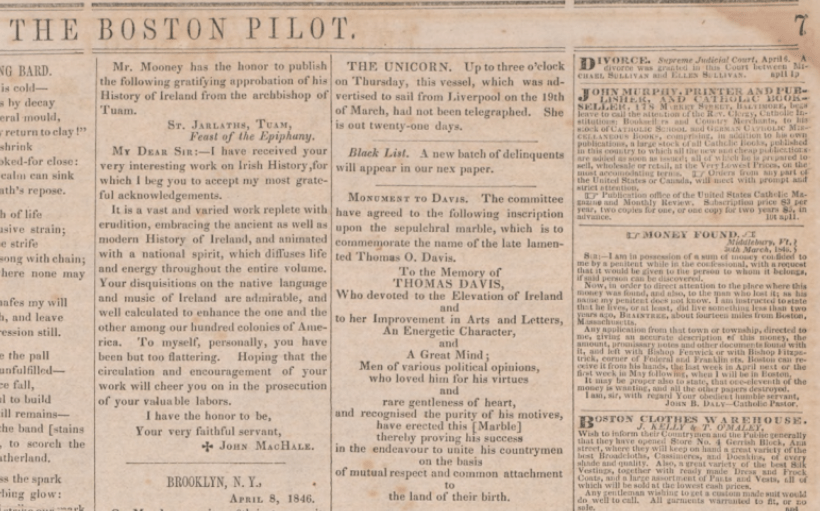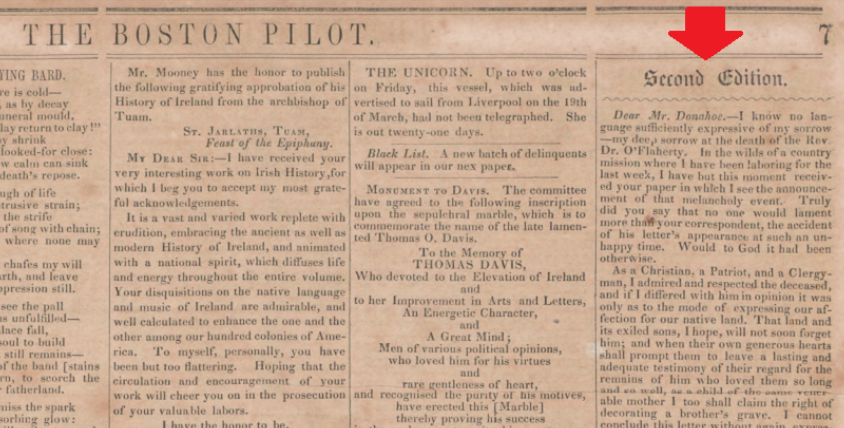
Whether in the business of creating fake or real news, every outlet is constantly looking for its base – a group of people with combined or similar interests who may see objective realities from particular perspectives. This was very much the case with the Boston Pilot. As Irish immigrants arrived in droves in the years leading up to and through the famine and troubles, the burgeoning Irish Catholic working class was struggling to find its way in Boston, much less America. The Boston Pilot served as a beacon for this community, spreading political and social ideas, while also providing a resource for reconnecting families, divided by cross-continental travel.
In 1829, The Jesuit, or, Catholic Sentinel, started publication as a periodical for Irish immigrants, and under the guidance of the Archbishop of Boston, Joseph Fenwick, Jesuit started to find its identity, eventually changing its name to the Literary and Catholic Sentinel in 1835, before becoming the much more well known Boston Pilot in 1836. Readership rose and fell as the decades brought the paper through the famine, troubles, and American Civil War until the archdiocese took over the paper officially in 1908.
Coverage spanning from 1838 to the early 1870s provides tremendous snapshots of:
- Irish immigration before, during, and after the famine;
- Crimean War news and updates;
- Details on the burgeoning abolitionist movement – including a story in which William Lloyd Garrison has his nose pulled.
The collection is comprised of five smaller collections of varying sizes, based on the name-changes of the paper through its history:
- Jesuit (1829-1831)
- United States Catholic Intelligencer (1831-1833)
- Jesuit, or, Catholic Sentinel (1833)
- Literary and Catholic Sentinel (1833-1835) This title is the first incarnation of the paper under the ownership and editorial control of Patrick Donahoe.
- Boston Pilot (1836-1837) This iteration of the paper only ran during 1836 and the first few weeks of 1837, before going on a year’s hiatus and being acquired by a new publisher in 1838.
- Boston Pilot (1838-1857) The title was used twice, during two distinct temporal periods
- Pilot (1858-1908) The Pilot is the seventh and current title of the longest running Catholic newspaper in the US. The paper has borne this title since 1858.
Perfectionism Pre-dates PDFs!
Recently discovered through the digitization process, several issues of this newspaper have a second edition. What is changed from one edition in the morning, to the other at night – and why would the Boston Pilot do this? See these Second Editions here along with an interview from Chris Mayo in conversation about how we scan and upload newspaper pages over a century old, and potential reasons for the Second Editions.


Interview with a Librarian
Gabriel Feldstein sits down with Digital Production Librarian Chris Mayo, who provides some insights about how the library digitized all of these thousands of pages, and some thoughts on the curious 2nd editions.
Q: When did you first realize that the Pilot was publishing Second Editions? Was it just two copies with the same date that didn’t match? What made you think to look for more – it seems very strange for a newspaper to have second editions.
CM: Yes, that’s precisely it. Due to changes over time in the digitization equipment and the copies of the paper that we have access to, I found myself in a position where I needed to compare images created from a physical copy held by the TML to a recently acquired gift volume in order to determine whether we should re-digitize that year of the paper. Essentially, I was looking to see if the copies in front of me were cleaner or less damaged than the copies that had already been imaged. Since the digital copies had been created before I began work at BC, I got really frightened when I noticed that the last two pages of the paper from a certain date were very different – I assumed that the image files had become misorganized and was dreading having to get everything back into the correct order. Then I noticed that on the second to last page of the physical paper in front of me there was a small header saying “2nd Edition”. It was a relief, but that’s when I realized we’d have to redo our workflows to incorporate checking and labeling the edition of each copy of the paper we digitized.
Q: Are some of the standalone issues we have in our collection Second Editions and we simply have no way of knowing?
CM: I hadn’t considered that, but I suppose it’s possible. We do check every paper for edition statements during the digitization process now, and papers generally either say “2nd Edition” or nothing at all – so we’re only assuming that all papers lacking edition statements are First Editions.
Q: Dealing with the quality of a copy of the Globe from last month is difficult – how were we able to maintain these hundred-year-old copies, and how did we get these massive volumes digitized without doing more damage?
CM: This has always been the biggest issue in dealing with the digitization of historic newspapers, and it’s part of why the project here took as long as it did to really get off the ground. There’s always a trade-off between image quality and speed of digitization. In order for the online resource to be full-text searchable, we need to have Optical Character Recognition run over the files, which works best with a minimum resolution of 350-400 pixels per inch. Historically, it’s been impossible to achieve that resolution while imaging more than a single page at a time, which results in a lot of time wasted repositioning bound volumes under the camera or scanner. In the 1990s and early 2000s, many libraries disbound volumes of historical newspapers to make them easier to digitize, accepting that once the digital copies were created, they would be discarding the physical. For a variety of reasons, that wasn’t an acceptable solution for the majority of the papers held by Boston College at the Theology and Ministry Library, so we spent years trying to find unbound copies of the papers held by other institutions that we could borrow for imaging, or imaging vendors who were capable of imaging bound copies to high specifications for reasonable prices. Neither solution worked very well, and in the first seven years or so of the project, we only managed to get about 20 years of the 79 we intend to digitize online.
In 2017 we purchased a new Digital Transitions copy stand for our digitization lab, with a 100 megapixel Phase One camera, which allows us to capture an entire two-page spread of newspaper in one shot at a good resolution. It was a true game-changer, letting us digitize faster, in-house, and without disbinding our copies. In the last year we’ve put 19 additional years of the Pilot in its various titles online, plus updating 6 previously-uploaded years with newly discovered and digitized second editions. Another 8 years have been digitized in the past few months and are currently being processed for upload. It’s really amazing how much more we’ve been able to do with the new equipment, and we’re very grateful to our colleagues in the TML for letting us digitize their copies of the paper now that we can do it non-destructively.
Q: Do you think each week had a second edition – or that this was something that was done more randomly when they received an article after the initial printings?
CM: It’s difficult to say. We only have the surviving papers to go by, and I would guess that most of the copies that we’re using were bound together as collections at least 70 years ago, if not longer. We don’t really know anything about how the people who were collecting these went about it. The holdings of the papers at the TML seem to contain two or three different collections in different colored bindings that were likely assembled at different times in the past. We have the data to analyze whether any of these collection groupings are more likely to contain second editions, which could indicate differences in collection strategies / policies, but I haven’t run the numbers on that.
Q: The Boston Pilot had a very wide national circulation as a Catholic paper – did this have to do with any of their second editions? Perhaps, certain articles for certain places?
CM: From what I know about 19th century newspapers, that’s certainly possible. There were generally one of two reasons for printing multiple editions: you might have a morning and an evening edition (which seems slightly odd in the Pilot’s case, as a weekly paper), or you might have a hometown edition and one or more regional editions that were shipped out to other parts of the country. The one reason I’m reluctant to assume that’s the case with the Pilot is that regional editions are often labeled with the city or region they are to be distributed to, not a flat numerical edition statement. I’ll be interested to hear if anyone does an analysis on the second editions and finds out that the differences in content might indicate a regional component.
Q: The Pilot’s second editions seem to be bunched during certain times – particularly in 1846 and then again they run a few in nearly consecutive months in the summer of 1855, is this just random, or perhaps they ran second editions only when they could afford it?
CM: I’m not sure – there are a lot of potential reasons for the inconsistency. It could simply be sampling bias; it may be that there were many more second editions printed than made their way into the surviving collections. If it were purely a financial or cost issue, I would expect to see more second editions from the 1860s and early 1870s, which we’re currently working on getting online. Those seem to have been the heyday of the paper. According to a dissertation written in the 1950s by a BU student, the owners bought a new, modernized printing press to support greater circulation in the early 1870s, just in time for it to be destroyed by the Great Boston Fire. I will note that your mention of 1846 makes me wonder if second editions were more common during years when there was momentous news arriving from Europe, since that’s the second year of the Irish Famine. I’m not sure what the news from 1855 might be about, though.